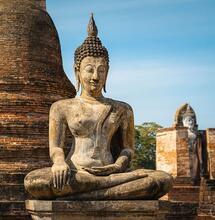Pot for Amateurs

For the less savvy among our readers, we at SSUSA decided to begin penning articles aimed solely at the beginner. We present to you the '101' series - an introductory approach aimed at educating less-experienced smokers and growers.
Answering beginner's questions that you're too ashamed to ask...
Recent polls suggest that more Americans than ever before support the legalization of Cannabis - at least for medical use. Now that sixteen different states have enacted some form of pro-pot legislation, folks from across the country are gaining access to the alternative medicine - many of whom have not smoked for years or have never even tried it before. There are a few basic things that most Cannabis users know, either gleaning knowledge through exposure to like-minded individuals (albeit in a mostly-clandestine fashion) or from an active search for information that will enlighten them on their favorite subject.
This on-going quest for knowledge should be an integral part of your Cannabis education, as there are countless varieties (or 'strains') of weed out there, all supplying the consumer with a distinct flavor, aroma, effect and duration. You should also keep in mind that each grower, while superficially adopting similar methods to others, can and will make mistakes, and not many people actually know what happens in the grow rooms of others.
Not everyone who supplies the dispensaries, for example, is in this business just to help the sick and needy. Greed or just plain ignorance often leads to low-quality products. If you are a medical user you need to be especially careful to seek out well-grown, clean and high quality medicine from safe, trusted dispensaries or collectives. So, what does one look for in a good bud of weed? First you need to know some basic background information. We will get into more detail as this series progresses.
The Plant Itself:
The Cannabis plant has thrived across our planet for thousands of years. It grows healthy and green in the springtime and flowers, seeds and dies in the autumn to early winter. Equatorial strains, known as the 'haze' family, have a slightly different growth pattern due to their location and genetics. The flowers often present dazzling color displays: silvery white to copper orange, to deep crimsons and amethyst purple varieties.
Those are good colors; musty browns and dull, limp gray-green buds might be moldy or covered in pests, mildew, etc. If it smells or looks 'spoiled', discard it (in a tightly-sealed plastic bag to prevent cross-contamination). While there are countless varieties of Cannabis, both wild and cultivated, most people think of two distinct subsets: 'marijuana' and hemp.
Hemp generally refers to Cannabis plants whose flowering tops contain only trace amounts of the drugs, or cannabinoids, that are responsible for intoxicating the consumer. Instead, each part of the hemp plant may be used in a myriad of ways, generally explaining why people call these the 'industrial' plants. Industrial hemp can produce over 20,000 different types of products, replacing fossil fuels and paper as major production components.
While it can produce fabric, paper, rope, fuel; polishes, paints and varnishes, human- and animal food, medicine and much more, the cultivation of hemp is also incredibly beneficial to the environment. The only thing that hemp will not produce is the drug effect for which its cousin is famous. Male and female plants look pretty much the same - until the days get shorter and the plants begin to flower.
Male plants are decorated with tiny round pollen sacs; female flowers begin as little white V-shaped hairs known as pistils, which continue to appear and mature, eventually developing into the buds with which many are familiar. It is only the flower of the female that is smoked - not the leaves, male flowers, stems or roots. Male plants pollinate the females, fertilizing them and resulting in the plant producing seed - the next generation from that combination of parentage, which will sprout the following springtime.
This actually changes the drug effect of smoke-able Cannabis, so most growers strive to keep any males out of their gardens, indoors or out-. They are producing buds known as 'sinsemilla', or 'without seeds'. Usually male plants are cut down and disposed of as soon as a grower is able to identify the gender of the plant. Industrial hemp farms generally grow both genders of plant, especially if they are farming the hemp for seed.
This, and the close proximity in which hemp plants are grown, is the easiest way to tell that you have stumbled upon an industrial farm - and not an illegal grow-op. (Although, the nationwide absence of hemp farms ensures that you are in America, as hemp cultivation remains illegal here; it is promoted in many other countries.) You can smoke hemp flowers, but all you'll get is a headache.
Smoke-able Cannabis - also known as pot, marijuana, ganja, weed, chronic, grass, dope, herb, kind, dank - or even 'the reefer' - does not lend itself to any industrial applications. The plant's female flowers contain varying amounts of cannabinoids, the unique ratio and combination of which makes every strain deliver its own blend of strength, smell, taste and effect. Generally you can achieve one of two feelings from pot: uplifted, energized and 'high', or relaxed, sedated and 'stoned'.
If you don't want to feel either of these effects, don't use Cannabis. For your higher moods, the sativa family (tall, graceful plants with slender leaves and delicate flowers) will generally deliver a 'buzzed' feeling; if you are a very high-strung or tense person this family might actually increase your anxiety.
Conversely, many depression patients report that sativas help to 'bring them up' enough to go about their normal routines. Sativas can also be used to treat some types of pain. Always consult your physician and ask for dispensary recommendations before attempting Cannabis therapy; self-medication can be detrimental by exacerbating other conditions.
It is imperative that you choose the correct family of Cannabis for your particular ailment. If you like the sativas, try the hazes. Haze plants (pure equatorial sativas) are the pride of old-school smokers, many of whom lament the extinction of the true '60s and '70s legends. This smoke, which some insist smells of cat urine, tends to deliver the absolute 'highest' effect of all the Cannabis varieties.
Research into the positive effects of haze on ADHD has been pursued over the past decade or so. While smokers love them, growers find these the most difficult to cultivate. Hazes tend to be tall, stringy and lithe plants, dotted with pointy flowers and sparse, thin leaves. Indica plants tend to be short, bushy and darker green, with wide leaves.
The dense, compact buds deliver a full-body 'stoned' feeling, great for relaxing muscles and easing tension. Ailments such as multiple sclerosis and insomnia are often treated with these strains. Too much indica and you won't leave your couch! Stay tuned for future installments of our new 101 series. We'll explore hemp, hash, medicinal applications, cannabinoids, and much more.



